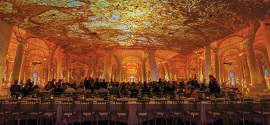Meetings + Events
The power of gathering people
The power of gathering people
Find out how many people will fit in your room or what size room you need for your number of attendees.
Step 1
Choose a Room Layout type:
Step 2
Enter one of the following to determine the other:
Room Size:
sq.ft.
Capacity:
NOTE: This is a starting guideline only. Accuracy for your particular event cannot be guaranteed.
Prague Presents New Event Venues and Expects More to Follow
![]()
The Destination by Hyatt brand debuts in Canada with Hotel X Toronto
![]()
The Parkside Hotel & Spa Announces Partnership with Sierra Club BC for Earth Month
![]()
Canada and Yukon announce funding to build a new convention centre in Whitehorse
![]()
 Bring events to life with the magic of projection mapping
Bring events to life with the magic of projection mappingBy Sandra Eagle
Projection mapping adds a layer of dimension to events that you just can’t get from mounds of decor.
Projection mapping is the integration of projectors and computer software to project still or video images onto any surface, whether it be a table, wall, ceiling or building.
Alissa Hurley, CMM, DES, CED and vice-president of marketing at FMAV, based in Ottawa, says projection mapping can go on pretty much any surface, from flat wall to wooden or fabric inlays—what you would find in almost any convention centre across the country. “In fact, mapping can take advantage of those different surfaces to create dimension,” she says. The scope of the technology is practically limitless.
Costs vary for projection mapping, depending on the duration, complexity of the program and the type of graphics desired.
Daniel Davidson, who describes himself as chief luminosity officer and owner at The Temple House, an event venue in Miami Beach, Florida, has gone as far as creating his own production company to produce incredible projection mapping and video displays. “The technology is getting better as the affordability of software and the power of computing is increasing. You are able to do more for less,” he says. Content is still king though, as lead time for projection mapping displays are dictated by the types of images a client wants. Davidson adds, “If it’s a luxury client, they supply the content library to us in the form of JPEGs or files that will need to be transcoded, compressed and put into a format that the computer can understand.”
 Davidson says he can shave days off of lead times if a client wants to utilize the large content library that The Temple House has purchased. “We have thousands of images, from flowers to waterfalls, firework displays to fractals [graphic patterns]. We can also layer imagery as well.”
Davidson says he can shave days off of lead times if a client wants to utilize the large content library that The Temple House has purchased. “We have thousands of images, from flowers to waterfalls, firework displays to fractals [graphic patterns]. We can also layer imagery as well.”
Essentially, Davidson says, “the computer system acts as a conductor in a symphony of light. The computer instructs the projectors where to simultaneously deliver light. The projectors must dovetail together to create the perfect seamless image.”
The complexity arises with the prep work. The operator has to work with the software to map the surface where the images will be displayed.
other articles in this section
Five Cool Things at…the Destinations International Annual Conference
Tips for the Accidental Meeting Planner
How Destination Vancouver is Building a Social Procurement Strategy
The Dilemma: The Rising Cost of Events
Event Profile: Raising funds and spirits
Green Business = Good Business
Case Study: Testing event restrictions
Case Study: Virtual Awards Show
Case Study: A hybrid event for meeting planners
Case Study: Canadian Event Industry Awards
Case Study: 100-person virtual mentoring event
Event spotlight: ConferenceDirect meets at Caesars Forum Las Vegas
By the Numbers: October 2020 Edition
Grab the Mic, Grow Your Business
Should you give interns a turn?
Back to Business: Insights from the MTCC
Back to Business: Insights from byPeterandPauls Hospitality Group
Back to Business: Insights from Industry Associations
Must-haves for the New Reality
Back to Business: Insights from White Oaks Resort & Spa
Back to Business: Insights from Casa Loma Escape Series
Back to Business: Insights from JW Marriott The Rosseau Muskoka
The new reality for... Speakers
The new reality for... Caterers
The new reality for... Team Building
CanSPEP Connext Conference Kit
How to turn delegates into social media brand ambassadors
The new reality for… CONVENTION CENTRES
Your Event Contract Questions Answered
There's No 'i'solation in Team
New Direction in a Time of Need